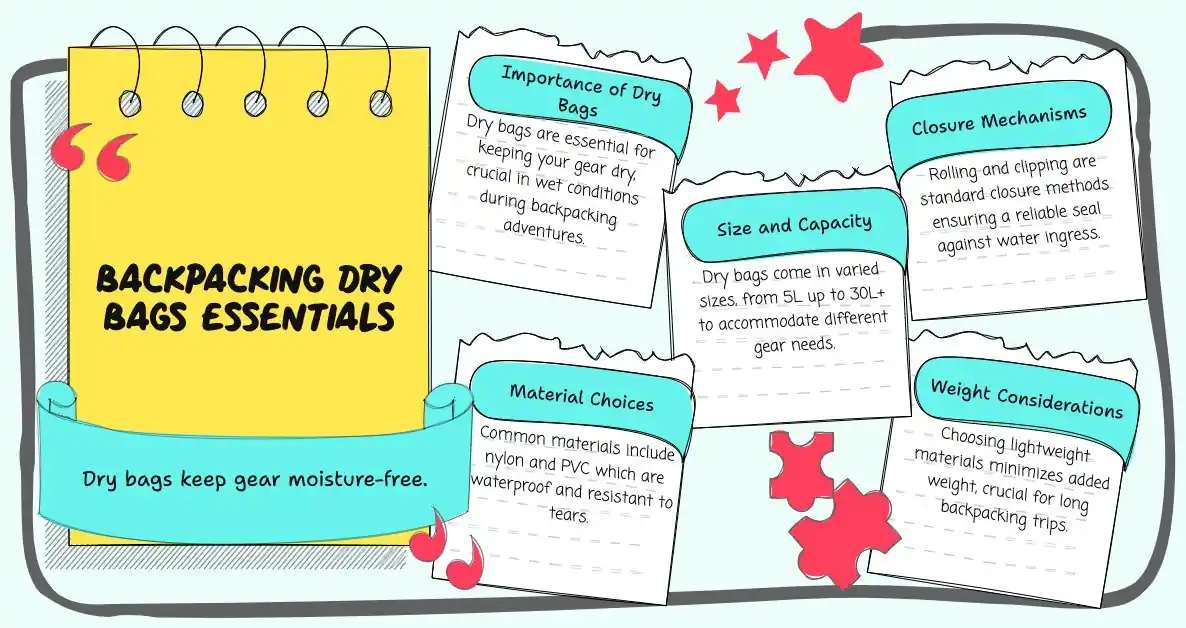When you're preparing for a backpacking trip, you'll quickly realize that dry bags are essential for keeping your gear organized and protected from the elements. But how many do you actually need? The answer isn't as simple as you might think.
While some backpackers swear by a minimalist approach with no dry bags, others choose to compartmentalize every item. Your specific needs will depend on various factors, including the length of your trip, the climate you'll be facing, and your personal packing style. To make the right choice, you'll need to evaluate each for your personal hiking style.
Tailoring Your Dry Bag Strategy for the Trail
When it comes to determining how many dry bags you'll need for backpacking, evaluating your gear requirements is the essential first step. First, assess your total gear volume, feeling out the weight and size of each item in your hands.
Consider the appropriate size for each category: a 5L bag for essentials, 10L for clothing, and 20L for sleeping gear. If you're carrying a synthetic sleeping bag, choose larger dry bags to accommodate its bulk.
This thorough packing enhances accessibility, allowing you to quickly grab what you need on the trail, your heart pounding with anticipation for the journey ahead.
Choosing Your Waterproof Arsenal
The range of dry bags offers a diverse array of choices to suit every backpacker's needs. You'll find sizes ranging from compact 1L pouches to spacious 50L behemoths, with 5L and 10L alternatives perfect for safeguarding your personal items and clothing.
As you start on your trail, you'll appreciate the ingenious closure mechanisms, from roll-down tops that seal out every drop to waterproof zippers that laugh in the face of torrential downpours.
For those who crave the thrill of ultralight backpacking, Dyneema or similar lightweight dry bags will be your loyal companions, conforming to the tightest of spaces without weighing you down.
These guardians of your gear will accompany you through whitewater fury and off-road odysseys, ensuring your essentials remain dry and secure.
Sizing Up Success: Key Dry Bags for Thru-Hikers

Now that you're familiar with the types of dry bags available, let's focus on the sizes you'll need for your backpacking adventure.
If you're venturing out for multiple days, don't skimp on space. A pack liner or possibly 20-liter or 30-liter dry bag will be your best friend, swallowing up gear and ensuring your sleep items and warmth gear stays bone-dry.
Don't overlook using smaller dry bags! A 2-liter bag is ideal for safeguarding personal items like your wallet and keys.
Keep in mind, a mix of sizes is key to efficient packing. By using multiple dry bags, you'll create a well-organized system that'll have you feeling like a true wilderness expert.
Mastering Trail Efficiency: Pack Like a Pro
As you prepare to pack your backpack, envision a well-organized system that'll make your hiking experience seamless. Imagine this: multiple dry bags, each with a specific purpose, nestled within your pack like a perfectly solved puzzle.
Start by categorizing your gear list into logical groups.
Your sleeping bag and sleep clothes, your warmth for chilly nights, deserve their own dry bag. Smaller 5-15L bags can be used for other "need to stay dry" items like clothes, ready for quick changes after unexpected downpours.
Don't forget a 5L bag or similar for those vital small items – your first aid kit, map, and compass – items you'll need at a moment's notice. Many choose to color-code these bags to make finding the right item simple and efficient.
By using a combination of waterproof stuff sacks and mesh bags, you're not just organizing; you're maximizing every cubic inch of space, ensuring that accessibility never comes at the cost of preparedness.
Battling the Elements: Advanced Waterproofing Tactics

When it comes to waterproofing your backpacking gear, you'll need to reflect beyond just keeping things dry. The wilderness can be unforgiving, and moisture is a tireless enemy. As you trek through misty forests or ford rushing streams, your heart races with the thrill of adventure, but your gear demands protection.
Invest in high-quality dry bags with a hydrostatic head of 2000+mm or more, ensuring your precious belongings remain untouched by the elements. This waterproof rating will ensure that your gear is shielded from the constant rain and dampness that tends to threaten thruhikes.
These specialized containers not only keep your gear dry but also mask enticing scents that might attract unwanted wildlife attention. With proper waterproofing considerations, you'll conquer the elements and focus on the awe-inspiring journey ahead.
The Thru-Hiker's Tightrope: Weight vs. Weather Defense

While waterproofing your gear is essential, it's equally important to strike a balance between protection and weight. The key lies in selecting lightweight dry bags that offer sturdy waterproofing without adding unnecessary bulk to your pack.
Embrace the functionality of a modular packing system, with each dry bag serving as a personal vault for your gear. One bag cradles your backpacking quilt and sleep clothing, while a more compact 5L pouch houses your trail essentials.
As you push through challenging terrain, the peace of mind that comes from knowing your gear is protected is invaluable. Using dry bags allows you to confidently trek through the wettest conditions, knowing your equipment is dry and ready for use.
This delicate balance of weight and protection guarantees you're prepared for whatever nature throws your way.






